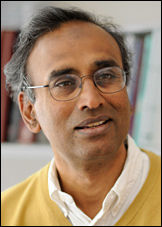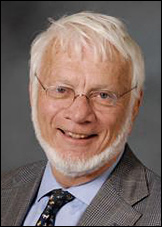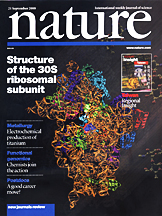Seminal Work for 2009 Nobel Prize in Chemistry Conducted at Brookhaven Lab
Venkatraman Ramakrishnan and Thomas Steitz used BNL's National Synchrotron Light Source to produce atomic-level images of ribosomes
October 7, 2009

Venkatraman Ramakrishnan (Photo: MRC Laboratory of Molecular Biology)
Two of this year’s three recipients of the Nobel Prize in Chemistry conducted a substantial part of their award-winning research at the National Synchrotron Light Source (NSLS) at the U.S. Department of Energy’s (DOE) Brookhaven National Laboratory.
Venkatraman Ramakrishnan, a former employee in Brookhaven’s biology department and long-time user of the NSLS, now at the Medical Research Council Laboratory of Molecular Biology in Cambridge, UK, and Thomas A. Steitz of Yale University, also a long-time NSLS user, share the prize with Ada E. Yonath of the Weizmann Institute of Science “for studies of the structure and function of the ribosome.”
Ribosomes make the thousands of proteins that are required for the structure and function of each living cell. Specifically, the ribosome translates the genetic instructions encoded by DNA into chains of amino acids that make up proteins. It is composed of two subunits: 30S, which reads the code, and 50S, which links up the amino acids.

Thomas A. Steitz
(Photo: Michael Marsland/Yale University)
Starting in the late 1990s, both Ramakrishnan and Steitz used a technique called x-ray crystallography at the NSLS to gather atomic-level structures of these two ribosome subunits, Ramakrishnan on 30S and Steitz on 50S. In this technique, scientists analyze how a beam of powerful x-rays is scattered by molecules arranged in a crystal to determine the positions of the molecule’s individual atoms.
Ramakrishnan began his work on ribosomes while employed in Brookhaven’s biology department from 1983 to 1997, first at the High Flux Beam Reactor and later at the NSLS. Even after leaving the lab to join the University of Utah, he used the NSLS to collect crystallography data that contributed directly to his Nobel Prize. In 1999, his research at NSLS beamlines, especially X25, resulted in the first report of a low-resolution structure of the 30S subunit. In 2000, Ramakrishnan helped uncover the high-resolution version of the structure, which was based on data from the NSLS, the Advanced Photon Source (APS) at Argonne National Laboratory and the European Synchrotron Radiation Facility.
At about the same time, Steitz worked with Brookhaven’s biology department to collect NSLS data on the 50S subunit. The first low-resolution structures were solved in 1998 and 1999 using NSLS beamlines X12B and X12C. In 2000, Steitz’ team presented the first high-resolution structure of 50S subunit using data from NSLS beamlines X12B and X25 and from the APS.
These studies map ribosome functionality at the most basic, atomic level – providing information that is a spring board for researchers to more detailed investigations. The structures of 30S and 50S have been crucial to understanding everything from how the ribosome achieves its amazing precision to how different antibiotics bind to the ribosome, knowledge that could help researchers come to grips with the problem of drug-resistant bacteria.
The NSLS is supported by DOE Office of Science. Support for operation of all three of the NSLS beamlines used in this seminal work came from the DOE Office of Science and the National Institutes of Health’s National Center for Research Resources.
Biographical Information on 2009 Chemistry Nobel Prize Winners
 enlarge
enlarge
Ramakrishnan's high-resolution structure of 30S ribosomal subunit, based on data collected at NSLS, APS, and ESRF, published by Nature in 2000.
Venkatraman Ramakrishnan is a U.S. citizen. He was born in 1952 in Chidambaram, Tamil Nadu, India. He earned his Ph.D. in Physics in 1976 from Ohio University. He conducted research at a variety of U.S. institutions before joining Brookhaven National Laboratory’s Biology Department in 1983, earning tenure in 1990. In 1997, he left Brookhaven Lab for the University of Utah, but maintained a guest appointment and continued to use the National Synchrotron Light Source at Brookhaven until 2001, conducting research that contributed to this year’s Nobel Prize in Chemistry. He is currently a Senior Scientist and Group Leader in the Structural Studies Division, MRC Laboratory of Molecular Biology, Cambridge, UK.
Thomas A. Steitz is a U.S. citizen, born in 1940 in Milwaukee, WI, USA. He earned his Ph.D. in Molecular Biology and Biochemistry in 1966 from Harvard University, MA, USA. He is currently the Sterling Professor of Molecular Biophysics and Biochemistry and a Howard Hughes Medical Institute Investigator at Yale University, CT, USA. Steitz has used the NSLS at Brookhaven National Laboratory since the late 1990s to conduct x-ray crystallography experiments that contributed, in part, to his winning a share of the 2009 Nobel Prize in Chemistry.
Ada E. Yonath is an Israeli citizen, born in 1939 in Jerusalem, Israel. She earned her Ph.D. in X-ray Crystallography in 1968 from the Weizmann Institute of Science, Israel. She is currently the Martin S. and Helen Kimmel Professor of Structural Biology and Director of Helen & Milton A. Kimmelman Center for Biomolecular Structure & Assembly both at Weizmann Institute of Science, Rehovot, Israel.
2009-11016 | INT/EXT | Newsroom









